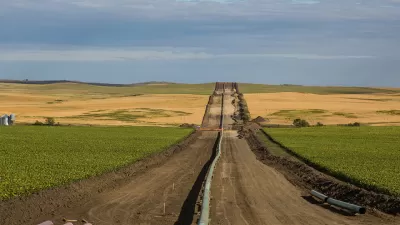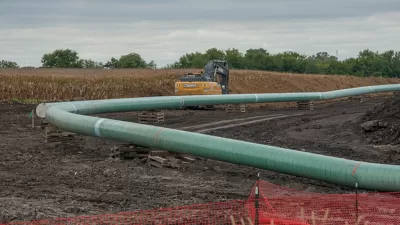Following through on a January executive action, President Trump announced Friday that he was approving the oil pipeline that his predecessor had rejected over a year ago. Oil is already flowing from Steele City, Nebraska to Gulf Coast refineries.

On March 24, President Trump's State Department "signed and issued a Presidential Permit to construct the Keystone XL Pipeline," announced the Calgary-based pipeline builder, TransCanada Corporation. As posted in January upon the president's signing a memorandum giving conditional approval to the Alberta to Nebraska pipeline, the pipeline will carry oil sands crude from Alberta and Bakken oil from North Dakota to the Gulf Coast refineries.
As readers who have followed the nine-year Keystone XL saga (see the Associated Press timeline, which begins in March 2008 with the original Keystone pipeline approval and September 2008 filing by TransCanada for a new Keystone XL route) will recall, former President Obama rejected the trans-national pipeline on Nov. 6, 2015.
Oil has been flowing through the southern, 487-mile leg of the pipeline (Phase III) from Cushing, Okla. to the Port Arthur, Texas region since January 2014. Phase II, from Steele City to Cushing, began operation in 2011. All that was missing was that Presidential Permit to enable a new (hence the "XL") trans-national crossing that required a Republican president to succeed President Obama.
Courtesy of Wikipedia: Keystone Pipeline Route, Phases 1 through 4.
However, the saga doesn't end with Friday's approval. The 1,179-mile Phase IV "shortcut" running from the oil sands of Alberta, Canada, through Montana to Steele City, Nebraska still faces hurdles before it can transport 830,000 barrels a day of oil sands crude from Alberta and Bakken crude from North Dakota, reports Clifford Krauss, The New York Times' national energy business correspondent.
It needs the approval of the Nebraska Public Service Commission and local landowners who are concerned about their water and land rights. Protests are likely since the project has become an important symbol for the environmental movement, with the Canadian oil sands among the most carbon-intensive oil supplies.
Krauss describes the "mixed-blessing" reaction by Prime Minister Justin Trudeau: good for the Canadian economy, but a likely setback for meeting his climate targets. [See related post this month on Trudeau's award from the energy industry.]
What happened to U.S.-manufactured steel for the pipeline?
Remember President Trump's insistence, solidified in a presidential memorandum on Jan. 24, that pipelines that run through the United States be manufactured domestically?
"We are -- and I am -- very insistent that if we're going to build pipelines in the United States, the pipe should be made in the United States," Trump said on Jan. 24. [Cleveland.com]. Krauss writes that "the White House has since suggested that the Keystone project would not be subjected to those rules because it is not a new project."
However, the Sierra Club provides a different explanation for Trump's reversal: "According to reports, TransCanada's threat to continue [it's $15 billion] NAFTA suit contributed to the White House decision to renege on Trump's promise that the pipeline would be made with U.S. steel." An hour after President Trump made his announcement, TransCanada dropped its suit, the Club reports.
Notwithstanding President Trump's announcement in the White House on Friday that "[i]t’s a great day for American jobs and a historic moment for North American and energy independence," don't expect President Trump to appear at any Ohio steel plants announcing new jobs.
FULL STORY: U.S., in Reversal, Issues Permit for Keystone Oil Pipeline

Alabama: Trump Terminates Settlements for Black Communities Harmed By Raw Sewage
Trump deemed the landmark civil rights agreement “illegal DEI and environmental justice policy.”

Planetizen Federal Action Tracker
A weekly monitor of how Trump’s orders and actions are impacting planners and planning in America.

How Atlanta Built 7,000 Housing Units in 3 Years
The city’s comprehensive, neighborhood-focused housing strategy focuses on identifying properties and land that can be repurposed for housing and encouraging development in underserved neighborhoods.

Report: Zoning Reforms Should Complement Nashville’s Ambitious Transit Plan
Without reform, restrictive zoning codes will limit the impact of the city’s planned transit expansion and could exclude some of the residents who depend on transit the most.

Judge Orders Release of Frozen IRA, IIJA Funding
The decision is a victory for environmental groups who charged that freezing funds for critical infrastructure and disaster response programs caused “real and irreparable harm” to communities.

‘Clybourne Park’ Sets Stage for Housing Equity Discussions
Clybourne Park, a play exploring race, real estate, and community tensions, can set the stage for discussion on the lasting impacts of housing discrimination, gentrification, and the fight for affordability.
Urban Design for Planners 1: Software Tools
This six-course series explores essential urban design concepts using open source software and equips planners with the tools they need to participate fully in the urban design process.
Planning for Universal Design
Learn the tools for implementing Universal Design in planning regulations.
Caltrans
Smith Gee Studio
Institute for Housing and Urban Development Studies (IHS)
City of Grandview
Harvard GSD Executive Education
Toledo-Lucas County Plan Commissions
Salt Lake City
NYU Wagner Graduate School of Public Service






























